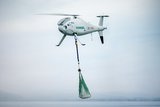More Puma AE UAV orders from US military
AeroVironment has announced a number of new orders for its Puma AE small unmanned aircraft systems (SUAS), including a firm fixed-price order valued at $20,430,433 from the US Army, and a firm fixed-price order valued at $5,558,479 from the US Marine Corps (USMC). The Puma AE systems will provide intelligence, surveillance and reconnaissance capabilities for security, route clearance operations and overall battle space awareness to US forces in Afghanistan.
Delivery for the US Army is scheduled to take place within thirty days. The USMC order, made through an existing US Army contract, is scheduled for delivery within two weeks.
In 2003, the Marine Corps became the first US military service to establish a programme of record for small unmanned aircraft systems with their competitive selection of AeroVironment’s RQ-14 Dragon Eye for the Small Unit Remote Scouting System (SURSS) program. In 2007, the Marines procured AeroVironment Wasp systems and then replaced their Dragon Eye fleet with AeroVironment’s RQ-11B Raven system starting in 2009. With the procurement of Puma systems the Marine Corps is the first service to adopt four different AeroVironment small UAS.
The United States Special Operations Command (USSOCOM) selected the Puma UAS in 2008 for its AECV programme after a full and open competition, the fourth US Department of Defense competition for programmes of record involving small UAS and the fourth such competition won by AeroVironment. In 2011 the United States Army assumed management of the AECV programme.
Separately, AeroVironment has announced the production and delivery of its 1,000th Puma AE air vehicle, reflecting strong interest in and demand for the capabilities provided by the Puma AE system. In parallel, the United States Air Force approved the Mission Design Series designation RQ-20A for the Puma AE UAS. This designation establishes the Puma system alongside AeroVironment’s RQ-11B Raven system as a designated military aircraft.
Each Puma system consists of three air vehicles and two ground control systems. The air vehicle carries an integrated electro-optical and infrared gimbaled video camera, is designed for enhanced survivability in land and maritime environments, and can operate effectively in foul weather and over rugged terrain. Its quiet operation, stabilised imagery and precision landing capability make Puma systems easy to operate and recover. The Puma air vehicle weighs 13 pounds, is battery powered and has a flight endurance of two hours.
More from Uncrewed Vehicles
-
Jammer resistant drone designs spark search for countermeasures
The Russia-Ukraine conflict has driven another stage of evolution for drones and the counter measures to defend against them.
-
![L3Harris launches Amorphous software for control of uncrewed platforms]()
L3Harris launches Amorphous software for control of uncrewed platforms
The new Amorphous software is a universal controller that would allow a single operator to control a swarm of “thousands” of uncrewed systems, from drones to underwater platforms.
-
ideaForge unveils new UAVs at Aero India 2025
India UAV supplier ideaForge has launched the Netra 5 and Switch V2 drones at Aero India 2025, boasting of enhanced endurance, AI-driven autonomy and improved operational capabilities.
-
![Shaping the future of defence: What 2025 holds for the global drone market]()
Shaping the future of defence: What 2025 holds for the global drone market
The UAV market is experiencing unprecedented growth, with innovations in technology and battlefield applications driving demand across military sectors. From the battlefields of Ukraine to NATO exercises and beyond, drones are transforming how wars are fought and supported.
-
![Maris-Tech confirms customers signing up for Jupiter Drones codec and AI-powered system]()
Maris-Tech confirms customers signing up for Jupiter Drones codec and AI-powered system
Launched at AUSA in October, the company’s multi-stream video codec is attempting to bring a new lease of life to drone technology through its AI accelerator.
-
![AUSA 2024: Quantum-Systems targets big 2025 with UAS developments]()
AUSA 2024: Quantum-Systems targets big 2025 with UAS developments
Quantum-Systems has been upgrading its UAS family, with new versions of the Vector, Reliant and Twister drones set for release throughout 2025.
























